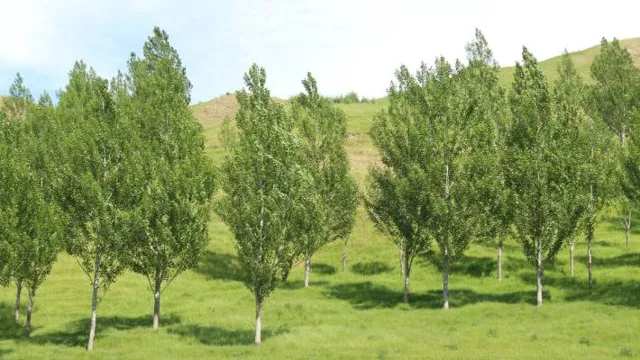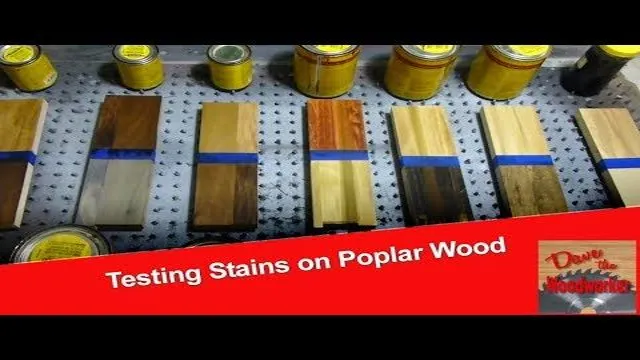When it comes to outdoor construction and design, finding the right wood for the job can be tricky. Many homeowners wonder if they can use poplar for their outdoor projects, considering its popularity for indoor furniture and trim. So, can poplar be used outside? The short answer is yes, but there are some important things to consider before making a decision.
In this blog, we’ll dive deeper into the properties of poplar, its durability against the elements, and its availability for outdoor use. Whether you’re planning a deck, fence, or another outdoor project, read on to find out if poplar is the right choice for your needs.
Understanding Poplar Wood
Yes, poplar wood can be used outside, but it may not be the best choice for high-moisture environments. Poplar is a versatile wood that can be used for a variety of applications, including furniture, cabinetry, and trim. It is a softwood that is easy to work with, making it a popular choice for DIY projects.
However, poplar is not as durable as hardwoods such as oak or maple, which means it may not hold up as well in areas that are exposed to the elements. Poplar can also be prone to rot and decay if it is not properly sealed or treated. If you do choose to use poplar outside, it is important to make sure it is properly finished and protected to help extend its lifespan.
Additionally, it is always a good idea to research and consider alternative woods that may be better suited for your specific outdoor project.
Physical Properties of Poplar
When it comes to the physical properties of poplar, there’s a lot to be said. It is a hardwood that has a low density, making it lightweight and easy to work with. However, even though it’s considered a hardwood, it’s actually quite soft and can dent or scratch easily.
Poplar wood can also have quite a bit of color variation, which can range from a pale yellow to a creamy white or even with greenish tones. Some people describe its color as being “earthy” or “natural.” In terms of its texture, poplar is smooth and even, with a straight, uniform grain.
Overall, poplar wood is a versatile material that’s used in many different woodworking applications thanks to its unique combination of physical characteristics.

Pros and Cons of Poplar for Outdoor Use
Poplar is a type of wood that is known for its versatility and affordability. It is widely used in furniture making, cabinetry, and even for outdoor projects. Poplar wood is a great choice for those who want a wood that is easy to work with, yet strong enough to withstand the elements.
One of the biggest advantages of poplar wood is its low cost, making it a popular option for those who want to save money without sacrificing quality. However, there are some drawbacks to using poplar wood outdoors, particularly when it comes to its susceptibility to rot and decay. While it can last for several years, it may not be the most durable choice for harsh weather conditions.
Overall, poplar wood is a great choice for those who want an affordable and versatile option for outdoor projects.
Factors to Consider for Outdoor Use
Poplar is a popular hardwood used for various woodwork projects, including interior and exterior applications. While it is not naturally resistant to decay, it can be treated with preservatives to make it suitable for outdoor use. However, there are several factors to consider when deciding to use poplar outside.
One of the most important factors is the degree of exposure to environmental elements such as moisture, heat, and sunlight. Poplar can be used for projects that are sheltered from direct sunlight or rain and relatively dry. However, when exposed to high levels of moisture or prolonged exposure to the sun, poplar may deteriorate quickly.
Therefore, it is vital to choose the right treatment to protect the wood from decay, rot and insect damage. Another important consideration is the grade of the poplar wood as some grades may be more resistant to decay than others. In general, poplar is a versatile wood that can be used for various projects, but careful consideration should be taken before using it outside.
Climate and Weather Conditions
When it comes to using outdoor spaces, it’s important to consider the climate and weather conditions. If you live in an area with extreme temperatures, you’ll want to think about ways to stay cool or warm depending on the season. In hot climates, you can use shade structures or install misting systems to cool down your outdoor space.
In colder months, you can use outdoor heaters or fire pits to keep warm. Another factor to consider is rain and storms. Will you need a way to shelter your outdoor furniture or appliances during inclement weather? It’s also important to consider the type of plants and landscaping you want to have in your outdoor space.
Make sure to choose plants that are appropriate for your climate and weather conditions, and that you have a plan for dealing with any weather events that could damage them. By taking these factors into account, you can create an outdoor space that is both functional and comfortable no matter the weather.
Location and Exposure
When it comes to using outdoor furniture, considering the location and exposure is crucial. This is because different outdoor elements can wear the furniture down over time and make it look unappealing. For example, if the furniture is placed in direct sunlight, it may fade or become discolored.
Similarly, placing it in an area that is prone to heavy wind can cause rust or damage to those made from lightweight materials. To avoid these issues, it is important to choose furniture that is designed for outdoor use and ensure that it is placed in a location that provides some protection from the elements. Additionally, it’s essential to regularly clean and maintain outdoor furniture to help prolong its lifespan.
Taking these factors into account when purchasing and placing outdoor furniture can help ensure that it remains both functional and aesthetically pleasing for years to come.
Surface Treatment and Maintenance
Surface Treatment and Maintenance are crucial considerations for outdoor use. The initial step is to select the appropriate surface material for your outdoor space. Materials such as concrete, stone, and wood are durable and ideal for outdoor environments.
In addition, you should also factor in conditions such as weather and traffic when choosing the material. Once you have your surface material, you need to treat it based on the manufacturer’s instructions to ensure it lasts long. Surface treatments such as sealants and coatings can help to protect and extend the lifespan of your surface material.
However, it’s essential to note that not all surface treatments are suitable for all materials. Therefore, you need to select the right treatment for your specific surface material. It’s also important to maintain your outdoor surface by cleaning it regularly, repairing cracks and damages, and providing proper drainage to prevent water damage.
By taking these measures, you can extend the longevity of your outdoor surface material and ensure it remains in excellent condition for an extended period, regardless of the weather conditions.
Conclusion
In short, using poplar wood outside is like trying to use a fork to eat soup – it’s not the intended use and won’t work as well as other options. While it may be tempting due to its affordability and availability, poplar is a lightweight and relatively soft wood that is prone to damage from moisture, insects, and decay. So while poplar may be a suitable choice for indoor projects, it’s best to leave it on the shelf when it comes to outdoor construction.
Stick to heartier woods like cedar, redwood, or pressure-treated pine to ensure your outdoor projects withstand the elements and stand the test of time. Happy building!”
Poplar Can Be Used Outside with Proper Precautions
Poplar is a great option for outdoor use with proper precautions taken into consideration. One of the main factors to consider is whether the wood has been treated or not. Untreated poplar is not ideal for outdoor use as it is prone to rot and decay due to exposure to moisture and insect infestation.
However, if the poplar has been pressure-treated or is a naturally occurring heartwood, it can be a fantastic option for outdoor projects. Additionally, it’s important to apply a protective finish that is formulated for outdoor use to help the wood resist fading, cracking, and warping. With the right care and precautions, poplar can be a long-lasting and beautiful addition to any outdoor space.
Consult with a Professional for Best Results
When it comes to outdoor use, there are several factors to consider before making a decision. One of the most important things to keep in mind is the type of environment the product will be exposed to. For example, if you live in an area with harsh weather conditions or high humidity, you need to choose a product that is weather-resistant and can withstand extreme temperatures.
Additionally, you should consider the amount of sunlight the area will receive as prolonged exposure to sunlight can cause some materials to fade or discolor. Another crucial factor to consider is the level of foot traffic the area receives. If the product will be exposed to a lot of foot traffic, you may want to choose a more durable material such as concrete or stone.
Lastly, if you’re not sure which product is best for your particular outdoor space, it’s always a good idea to consult with a professional who can guide you through the process and help you make the best decision for your space. Ultimately, the key to successful outdoor design is finding a product that will both function well and look great in your space.
FAQs
What makes poplar a suitable wood for outdoor use?
Poplar is a good choice for outdoor use because of its ability to resist decay and weathering. It is also lightweight and easy to work with.
Is poplar a waterproof wood?
While poplar is not completely waterproof, it does have good resistance to moisture and can be treated to increase its water resistance.
Can poplar be stained or painted for outdoor use?
Yes, poplar can be easily stained or painted to match the outdoor environment. It is important to use a high-quality outdoor stain or paint to ensure durability.
How does poplar compare to other types of wood for outdoor use?
Poplar is a suitable wood for outdoor use, but it may not be as durable as cedar or redwood. However, it is a more affordable option that still offers good resistance to decay and weathering.
Does poplar require any special maintenance for outdoor use?
Poplar requires regular maintenance such as cleaning and sealing to prolong its lifespan. It is also important to avoid prolonged exposure to moisture and sunlight.
Can poplar be used for outdoor furniture?
Yes, poplar is a popular choice for outdoor furniture due to its affordability and ease of use. However, it is important to properly seal and protect it to ensure durability.
What factors should be considered when using poplar for outdoor projects?
When using poplar for outdoor projects, factors such as climate, exposure to moisture and sunlight, and the type of project should be considered. It may also be necessary to treat the wood for additional protection.






